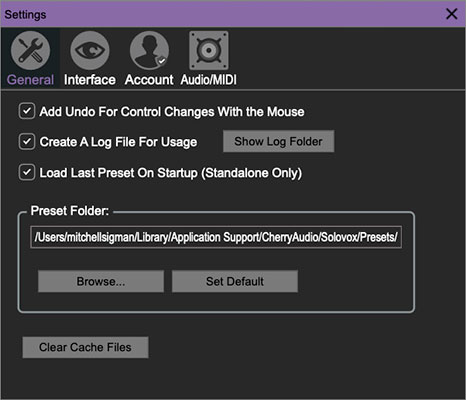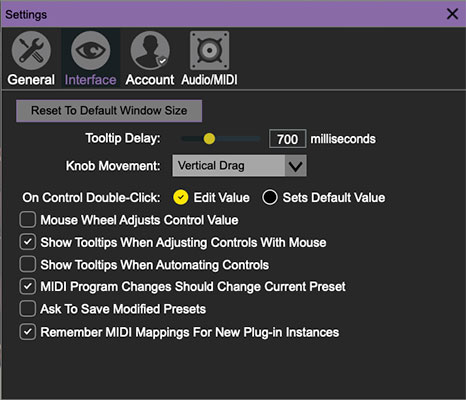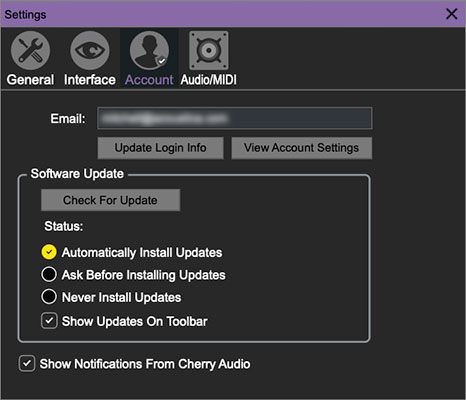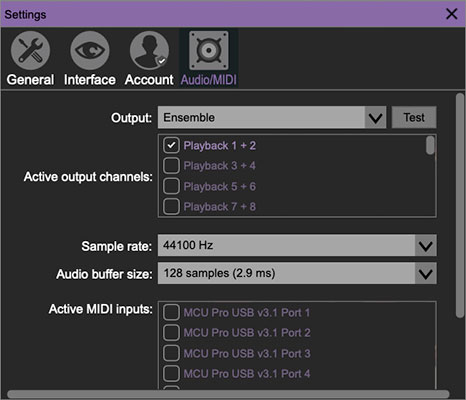Settings
Clicking the settings gear opens a window with multiple tabs for configuring various "under-the-hood" settings. These are mostly set-and-forget kind of parameters; everything you'll usually use is right on the panel.
Clicking the settings gear opens a window with multiple tabs for configuring various "under-the-hood" settings. These are mostly set-and-forget kind of parameters; everything you'll usually use is right on the panel.

Add Undo For Control Changes With the Mouse- Enabling this allows undo of knob/slider/button adjustments. You’ll want this on if you want the ability to undo all aspects of patch editing and programming.
Create A Log File For Usage- This creates a text doc of all of Solovox's internal and routines during use. It is mainly intended for our tech staff should you experience any issues. Clicking Show Log Folder opens the folder containing Solovox log file docs.
Load Last Preset On Startup (Standalone Only)- Automatically loads the last preset used when Solovox standalone version is started.
Preset Folder- Displays the current location of Solovox's sound presets. This can be changed by clicking and typing in the field.
Browse... - Displays the current location of preset folder in the file manager.
Set Default- Sets the current displayed Preset Folder path as the default location
Clear Cache Files- Deletes all log files, temporary sounds, and the image cache.

Allows customization of Solovox's user interface settings.
Reset To Default Window Size- Resets the Solovox workspace to default size. Use this to reset the window size if the window somehow becomes too large for your display and can't be resized.
Theme- Allows selection of 14 nifty floor surfaces beneath the pedals.
Tooltip Delay- Tooltips are those informative bits of text that pop up when hovering over a control (go ahead and try it, we’ll wait…). The Tooltip Delay setting defines how long you must hover before the tooltip pops up.
Knob Movement- Defines how mouse movements relate to turning onscreen knobs. It defaults to Vertical Drag, but can be changed to Horizontal Drag, or Rotary Drag if you're one those folks that cut their teeth on the Steinberg Model E VST back in 2000.
On Control Double-Click- Defines what happens when the mouse is double-clicked on a control. If Edit Value is selected, an exact number can be entered by typing the number and hitting [ENTER] or [RETURN]. If Sets Default Value is selected, double-clicking a control resets it to its default value.
Mouse Wheel Adjusts Control Value- Enabling this lets you adjust knob, slider, and switch values by moving the mouse wheel. This works great with a standard mouse wheel, but you'll want to disable it if you're using an Apple Magic Mouse (which will move the control AND scroll the window).
Show Control Tooltips When Adjusting Controls With Mouse- Displays parameter tooltips/values when the mouse is hovered over a control or as a control is moved with mouse clicked.
Show Tooltips When Automating Controls- Displays parameter tooltips/values next to controls any time a control is changed, i.e. if a control is moved via an assigned MIDI controller or a Perform panel knob, etc.
MIDI Program Changes Should Change Current Preset- Allows MIDI program change messages to change Solovox patches.
Ask To Save Modified Presets- This opens a dialog window asking if you'd like to save changes if a patch has been edited and a new patch is selected. If you're the type that likes to click through presets and tweak a control here and there, it can be annoying to have a window pop-up asking if you'd like to save every time you switch presets - if you're that person, keep this off.
Remember MIDI Mappings For New Plug-in Instances- When enabled, Solovox remembers all MIDI Tab controller settings.

Settings for your personal login information and account.
Email- Displays the email address of the current login.
Update Login Info- No, this isn’t a place for news and tour dates for yacht rock superstar, Kenny Loggins. Clicking this opens the same email and password login screen you’ll see when initially launching Solovox.
View Account Settings- This opens your personal account page on the Cherry Audio Store website containing information about modules purchased and more.
Software Update
We often fix bugs and make improvements; below are options defining how Solovox handles updates.
Check For Update- Click this to see if an updated version of Solovox available.
Status-
Automatically Install Updates- Updates are automatically downloaded and installed.
Ask Before Installing Updates- By default, Solovox automatically downloads new versions of modules when available. Checking this box defeats automatic updates and will ask if you’d like to install updates when they become available.
We’ll never make changes that can potentially “break” existing patches but we recommend enabling Ask Before Installing Updates if you’re using Solovox for live performances or other “mission critical” situations.
Never Install Updates- Solovox never automatically installs updates.
Show Updates On Toolbar- Checking this will display an icon in the toolbar next to the logo letting you know there's an update available.
Show Notifications From Cherry Audio- We occasionally will fire off in-app advertisements; disabling this checkbox will hide them. We hate repetitive, annoying ads as much as you, so we won't use this feature too often. When we do, it'll be for something super cool (like a fabulous sale), so we recommend leaving it on.

Not to be confused with audiomidi.com, where I used to work (talk about a not-fun job), these are settings for audio and MIDI hardware input and output.
This tab is only visible in the standalone version of Solovox.
Output- Use this drop-down menu to choose a physical audio output source. This defaults to Built-In Line Output, i.e. your computer’s onboard system audio, but you’ll get better fidelity with an external professional audio interface. The biggest audible difference is usually reduced background noise or hum.
The Test button will produce a brief sine wave when clicked; this will help with troubleshooting, aka, “WHY THE HECK ISN’T THIS MAKING ANY NOISE?!?”
Sample Rate- This sets Solovox's global sample rate. Lower sample rates offer better performance, but if you have a fast computer, high sample rates may offer slightly improved fidelity.
Audio Buffer Size- As with any digital audio app, this defines performance vs. note latency, and will largely depend upon computer CPU speed. A professional external audio interface will almost always exhibit better performance than “built-in” system audio. Lower settings will result in less latency (in the form of faster response to notes played), but will increase the chances of audio gapping or crackling noise.
Active MIDI Inputs- Enable MIDI input sources, i.e. MIDI/USB keyboards, pad controls, MIDI knob/fader control surfaces, etc. Check boxes to enable one or more devices. If a MIDI/USB controller isn't working, make sure the appropriate box is checked here. (We put this this piece of info way in the back of the manual, to make it extra challenging to find out when things aren't working.)